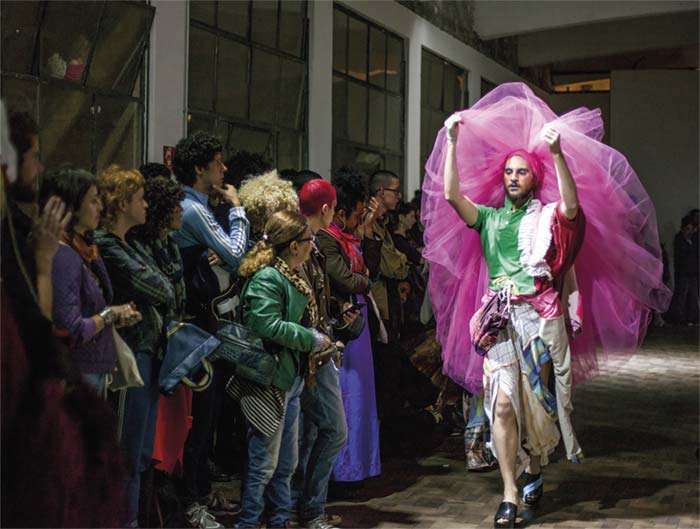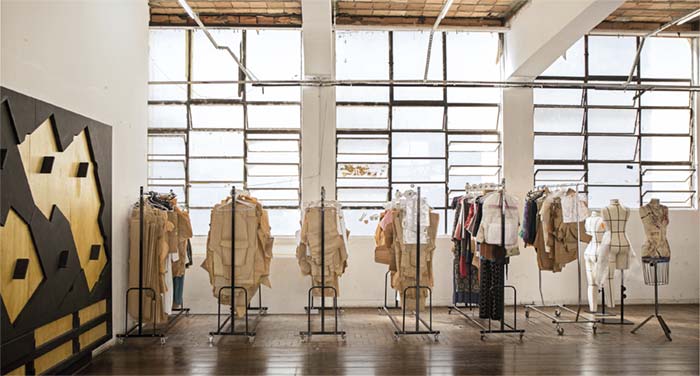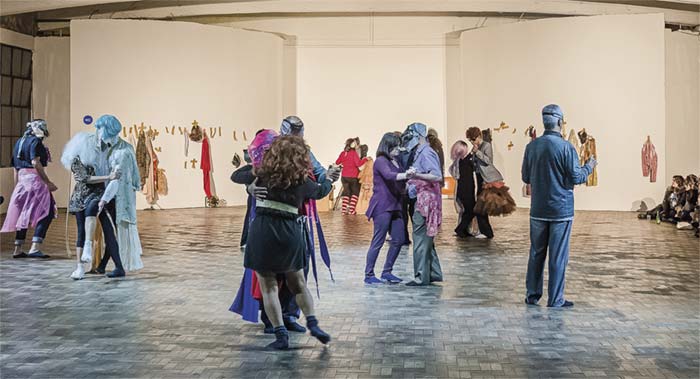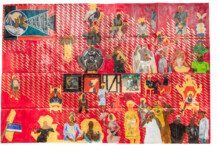
Until six or seven years ago, very few people in Sao Paulo – including those working with culture – could tell what Casa do Povo was. Cultural center founded in 1946 by progressive Jews in the district of Bom Retiro, the space was bitter about 30 years of crisis, with the closure of almost all its activities, and was more present in the memory of some generations than in the daily life of residents of the city. The fact is that in a very short time the house experienced an intense and vigorous recovery, consolidating itself as a prolific cultural center and one of the most open spaces for experimentation, political debate and multidisciplinary artistic practices in the town. Aimed at both contemporary production and the preservation of memory, Casa do Povo was inspired in its own history to gain fresh breath and life.
Nowadays, going to this space means to be faced with activities of the most varied and, at first glance, disparate. Depending on the season, one can witness a contemporary dance workshop to a journalism class for young people from the periphery; of a theatrical play made by secondary students to a Latin American publications fair; from an artistic performance to boxing offered to the neighborhood community; from discussions on health and female self-knowledge to production of workshops for graphic materials; from weaving workshops to free psychoanalytic services; from discussions on the integration of immigrants in the neighborhood to the rehearsal of a traditional choir sung in Yiddish; from a meeting about conscious eating to the distribution of meals. You can also consult a library and a vast documentary archive, purchase a copy of the newspaper Nossa Voz, edited by the institution, or leave from there with an audioguide to walk through the neighborhood of Bom Retiro and know its history.
If the practices are so many and diverse – and the list above could go on – they do not happen by chance, nor are they inconsistent with the proposal of a contemporary space of culture and art, as explained by the curator and cultural manager Benjamin Seroussi, director of the institution and one of those responsible for the resumption. “On the one hand, artists ask to broaden the notion of art, they do not want to limit themselves to traditional practices. They do not understand art as separate from other spheres of production and other life activities. On the other hand, culture is not limited to the arts. Casa do Povo is culture, culture is culture, sport is culture”, he says. “So here is creation, activism, people in situations of social vulnerability. But we never fail to understand it as a place of art. But a place of art that is trying to experience, in real scale, other possible worlds”.
Experiencing other possible worlds was certainly what the progressive Jews who founded the space in Bom Retiro shortly after World War II and the Holocaust wanted in the 1940s. And it is only through an understanding of this long history of the House, strongly intertwined with the political and cultural events of the 20th century, that one can understand the performance of the institution today. “Because all the resumption was made from a rereading of history. But not with the look of the historian, say, but more with the techniques of the healer. The idea is not necessarily to look for factual veracity – not that this is not important – but much more to think about how to use, and perhaps abuse, this story in the present”, says Seroussi.

Desfile/Performance de Vicente Perrota realizado em 2018
THE ANCIENT HISTORY
The history that the curator talks about referes to the 1930s and 1940s, when thousands of Jewish immigrants fleeing poverty and persecution in Europe began to inhabit Bom Retiro, in São Paulo’s downtown, and when two narratives come together. On the one hand, the emergence of anti-fascist associations – as in various parts of the world – created during the war to combat anti-Semitism, support the Allied countries’ struggle and, at the same time, a secular Jewish culture. Also, the desire to pay homage to the millions of dead in the Nazi concentration camps. “It could be made a memorial, a sculpture, with the names, where they would put flowers once a year. A gesture of remembrance is ready”, comments Benjamin. What was done, however, was a “living monument”, a space that brought together anti-fascist associations – such as the newspaper Nossa Voz and the Youth Club – and at the same time honored the dead. “The two narratives meet: the cultural center and the memorial. So it’s a memory space, but a place to remember is to act. A place where history is not written on the wall, but it is inscribed in bodies and architecture, and it is up to us to activate it”.
With a project by Ernest Mange – architect who worked with Rino Levi and Le Corbusier – Casa do Povo gained its headquarters in 1953. With three large decks with almost no partitions and a terrace, the modernist building on Rua Três Rios became a cultural center and space for political action. “It makes a lot of sense for Mange to have designed a building with these free plants, which allows you to adapt the spaces. I imagine he must have thought that the best building to remember is one in which each generation invents their ways of remembering. Because we never know how, tomorrow, we’ll remember yesterday”, says Seroussi. The space also housed the Brazilian Israeli Gymnasium Scholem Aleichem, a children’s school of renewed education (a humanist pedagogical line similar to Constructivism), and in 1960, it inaugurated in its subsoil the Brazilian Israelite Art Theater (TAIB), designed by the architect Jorge Wilheim .
With the coup in 1964 and the establishment of the military regime, Casa do Povo enters a troubled period of its history. While the newspaper Nossa Voz was closed by the government, the school increasingly housed children of persecuted politicians (including many non-Jews), who won scholarships and, if necessary, false names. Teachers came to be arrested and tortured and the institution became a pole of resistance to dictatorship, especially through the activities of TAIB. In it were staged pieces of the Arena Theater – by authors like Plínio Marcos and Augusto Boal – and the Sesi Popular Theater, among others. At the same time as the presentations filled the theater and the school continued to function, many members of the Jewish community moved away, out of fear of persecution or ideological disagreement, and financial difficulties increased.
“From the 1980s the Casa do Povo loses the enemy – the Dictatorship – the friend – the socialist bloc – and the social base – the Jews who lelf the neighborhood and often move away from the left-wing”, sums up Seroussi. In 1981 the college closed its activities, emptying even more space, in a period that the center of the city also lives a growing abandonment by the elites and the public power. If Casa do Povo did not completely close its doors, being maintained by the almost heroic performance of some associates, it entered a long period of crisis that only ended in the current decade.

RECENT HISTORY
It was more or less the story told to Seroussi in 2011 – certainly with more details and emotion – by the women who continued to go to Casa do Povo every week to sing in Yiddish in the Coral Tradition. It was in this period that the curator, after years of work at the Center for Jewish Culture, began to approach the building, located in a now mostly Korean and Bolivian neighborhood and with its rather dilapidated building. “Casa was not closed. These women have kept it heroically alive, but working as much as possible”, says Seroussi, referring to figures such as Hugueta Sendacz, now 92 years old and still a master of the choir. At the same time, as a result of the launch of the book Vanguarda Pedagógica (2008) and a mobilization through social networks, a group of Scholem alumni also became involved with the House and discussed the future of space.
It was from 2012, with a new board – which already included Seroussi – and an embryonic team that things began to change. “I had no money or employees, but I remember thinking: with this place, this history, this architecture and without paying rent, or I make things happen or I change my profession”, he jokes. “And we decided to do the same way it was done there in 1953. That is, put groups to use space. There came a fashion group, one of graphic design, one of urban activism. And today we have 25 groups or collectives using the house”. This time, no more people linked to the Jewish community, but from the most varied origins, transforming the institution into a space for meeting and socializing among different people. “If the Jew is the other, par excellence, a Jewish house must be open to all others. It has to be a space of radical alterity, open to the trans people, the black population, the indigenous people and the immigrants in the neighborhood”.
From a questioning on what should be a cultural center of the 21st century, and more specifically in that space, three major axes of work were defined. The first, gedenk (“remember” in Yiddish), guides the performance of the house as a living memory space, which tells the story of resistance of the groups that have gone through it, but seeks to bring this history to the practices of the present and future ideas. The second axis, tsukunft (“future”) emphasizes the experimental role of the house and the desire to make it a space to think about new artistic and multidisciplinary practices. The third axis, Farain (“association”), refers to how the first two axes could be worked, that is, through the action of collectives, autonomous movements and neighborhood associations that started to inhabit the place, living together and using the spaces so flexibly.

he three axes relate directly to an unavoidable question, according to Seroussi: “Here were groups of a political vanguard. It was built a modernist architecture building, had an experimental school and a Brechtian theater. Then the place condemns us to dare. It asks us to do differently”. Different even from what was done there in the 1940s and 1950s, in a radically different context. “When the Casa do Povo opened there were two or three cultural centers in the city. Today only that neighborhood places Pinacoteca, the Oswald de Andrade Cultural Center, the Sesc Bom Retiro, the Sala São Paulo, the Porto Seguro Theater, the Sacred Art Museum and the Container Theater. So we were going to make another place with exhibitions, theater season and shows? No, we wanted to do something else”, he explains. “Even because these spaces are fundamental, but I think they do not account for a series of contemporary artistic practices. Because I think they often separate culture from the other spheres of life”.
Today, with the groups and a schedule divided between what the institution organizes and what it hosts, the annual budget went from R$ 60 thousand in 2011 to R $ 1.2 million, captured between incentive laws, edicts, contributions from groups and associates, locations and an annual collection event – such as Caetano Veloso’s show in 2018. The institution’s library, after 40 years closed, was reactivated last May, representing another big step for the place in the sense of resuming its history and, at the same time, opening itself to society. “There have been several generations here, including many people who have died, but we have this collection, this archive, which is the hard core of the institution, which tells its story”, says Marilia Loureiro, curator and programmer at the institution. The next step is the restoration of TAIB, now quite degraded, in a planning that is already at an advanced stage.
The newspaper Nossa Voz, symbol of the institution, was relaunched in 2014 and is published annually with texts on current topics and collaborations of artists and intellectuals. In the last issue of 2018, the cover stamps the Herzog Vive! Manifesto published by the Jewish group for Democracy in the election period in reaction to the conservative rise and the possibility of the Bolsonaro election. On the following page, the transcript of the speech by the Israeli writer Amos Oz in June 2017, when he was on the house, shows a little of the spirit – past and present – of the Casa do Povo: “I really feel at home. Here is the right place to start a revolution, or at least, as my friend Lilia Schwarcz said, the right place to plan the revolution. Because it’s always nicer to plan it than to execute it”, he joked. If it will not be the epicenter of the revolution, the House is, returning to Seroussi’s statement, a place to rehearse other possible futures. “And everything that happens here confirms that our wishes were not crazy”, he concludes.









